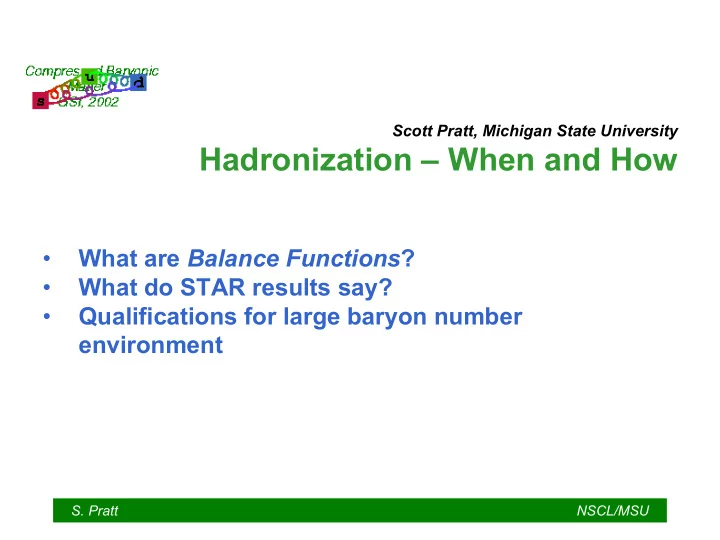

Scott Pratt, Michigan State University Hadronization – When and How • What are Balance Functions ? • What do STAR results say? • Qualifications for large baryon number environment S. Pratt NSCL/MSU
Charge is Created at Hadronization 1. Gluonic modes carry entropy, but no charge 2. Coalescence of quarks at same T should have: N mesons ~ N quarks + N antiquarks � quark number ~ doubles 3. Coherent sources (chiral fields, bag energy…) can produce new charge. • For B=0 QGP, >1/2 of charge is created at hadronization • For CBM, ???? S. Pratt NSCL/MSU
Balance Functions: How They Work For each charge + Q , there is one extra balancing charge – Q. Charges: electric, strangeness, baryon number S. Pratt NSCL/MSU
If one knows breakup T , one can determine σ δη Difficulty: Identifying balancing partners S. Pratt NSCL/MSU
Balance Function: Definition S. Pratt NSCL/MSU
Bjorken Thermal Blast Wave Model • Assume Q & Q produced at same point. • B 〈∆ y 〉 determined only by T, v ⊥ and m . • Proton balance function narrower that pion’s. • Thermal model always narrower than string model. S. Pratt NSCL/MSU
Bjorken Thermal Blast Wave Model • Assume Q & Q produced at same point. •B 〈∆ y 〉 determined only by T, v ⊥ and m . • Proton balance function narrower that pion’s. • Thermal model always narrower than string model. • Transverse flow narrows B( ∆ y) S. Pratt NSCL/MSU
What if Balance functions are narrower for AA than they are for pp? RQMD-type descriptions are qualitatively wrong AND EITHER 1. Delayed production of charge • Change in degrees of freedom • QGP least exotic explanation OR 2. Anomalously short mean free paths • would be contrary to common wisdom S. Pratt NSCL/MSU
RQMD, provided by Q.H.Zhang. What if AA balance functions are NOT narrower? • Gluonic modes did not contribute to entropy • No dramatic change in degrees of freedom. • Usual strangeness enhancement arguments are wrong. • J/ Ψ & Jet-quenching phenomenology are misguided. S. Pratt NSCL/MSU
Preliminary STAR Results M. Tonjes, ParkCity, 2001 Identified Pions More Central Collisions � Narrower Balance Functions !!! S. Pratt NSCL/MSU
The HBT Hole S.Jeon and S.P., hep-th (2001) No HBT HBT Weight: +HBT • Use parameters to get +Coulomb weight: T =190 MeV, λ =.7, R inv =7 fm Dip at small ∆ y • • Applied to non-partners • Proportional to dn/dy • Does not change norm. • No significant change in 〈∆ y 〉 • Dip similar to that seen by STAR S. Pratt NSCL/MSU
STAR Summary S. Pratt NSCL/MSU
STAR, width vs. centrality All Charges Identified Pions Blast Wave (extreme) As b � 0, data are consistent with ~100% delayed production with T ~ 110 MeV, v ⊥ ~ 0.75 S. Pratt NSCL/MSU
Can We Convict the QGP? 1. Analyze pp collisions. 2. Analyze K + K - and p-pbar balance functions. 3. Decipher p t dependence. 4. Study as functions of Q beam , Q out , Q side , Q inv . 5. Quantitatively understand normalization. (Loss of partners to other channels, e.g., π + balancing partner could be K − .) • Much can be accomplished with STAR’s 200 GeV data • PHENIX may be able to measure p-pbar balance function S. Pratt NSCL/MSU
Detector Requirements? 1. Large coverage, ∆ y >1.5 2. Good Particle ID over large range. 3. Equal Acceptance for + and − , e.g. STAR 4. Millions of Events S. Pratt NSCL/MSU
Recommend
More recommend